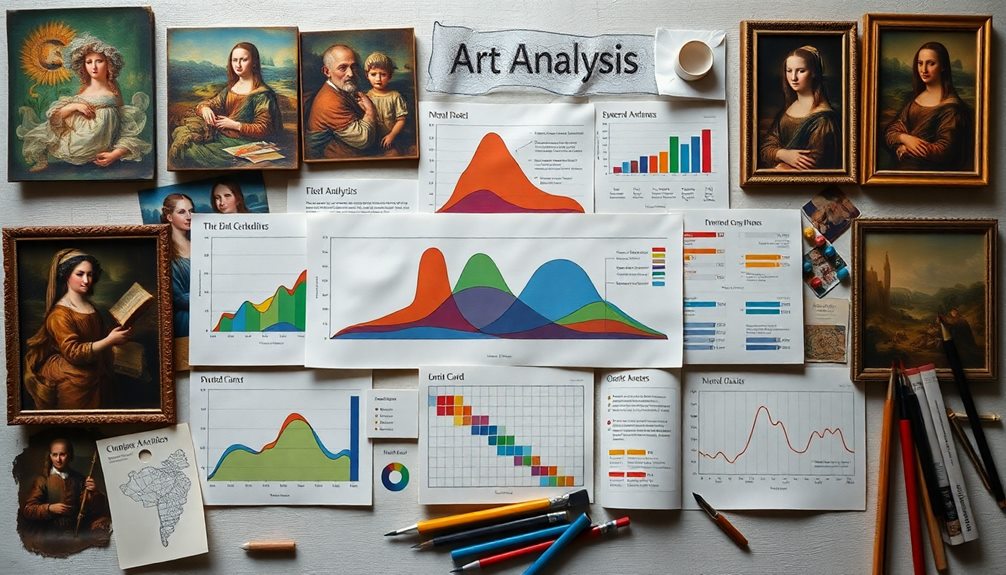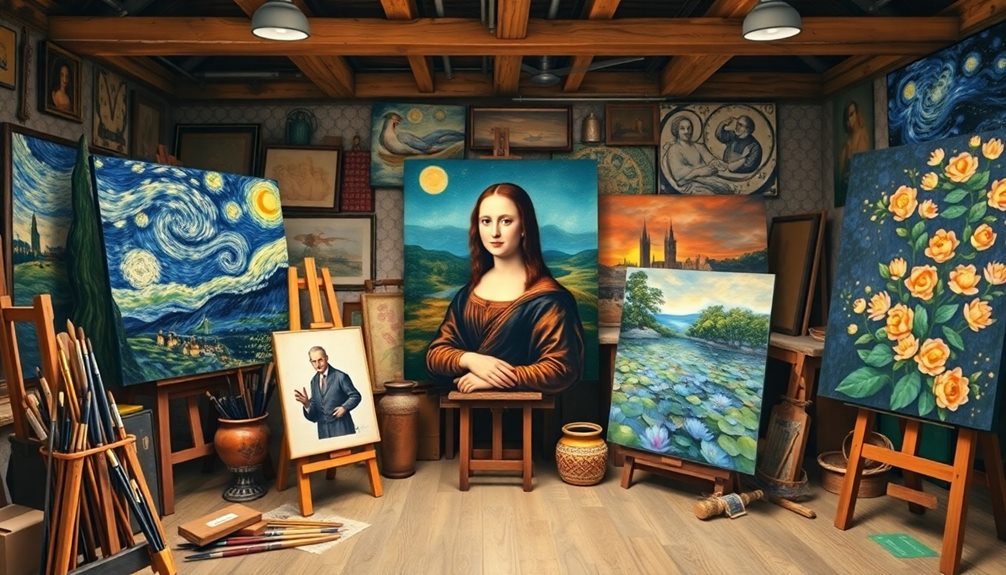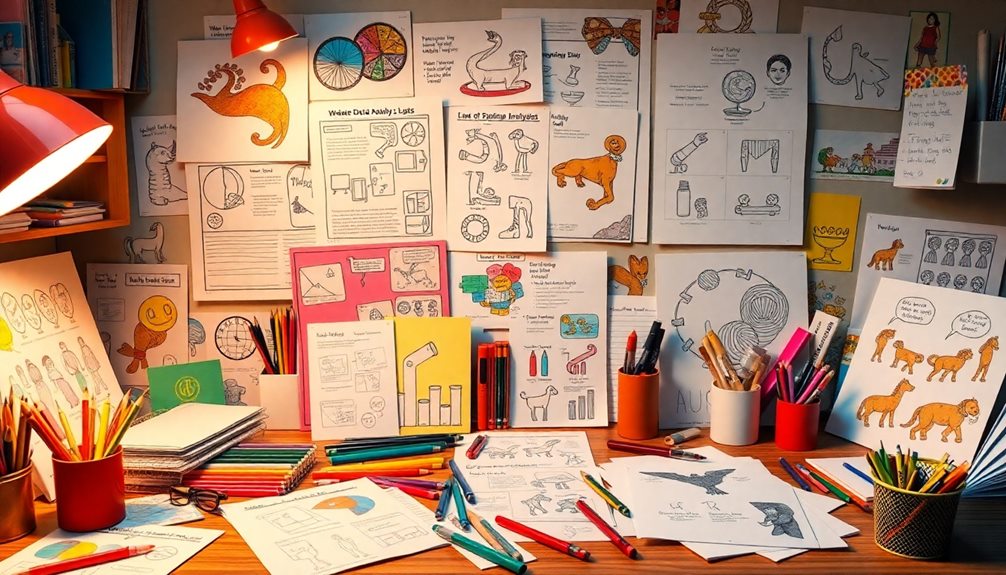Templates for art analysis papers help you organize your thoughts and enhance the clarity of your arguments. Start with a captivating introduction that includes the artwork's title, artist, and context. Then, use a structured framework to analyze visual elements like lines, colors, and textures. Each section should logically progress from description to interpretation, supported by visual evidence. Incorporating cultural context adds depth to your analysis and enriches your insights. By following these templates, you'll maintain focus and coherence in your work. If you're curious about specific examples and best practices, there's plenty more to explore.
Key Takeaways
- Structured templates enhance clarity and organization in art analysis papers, guiding writers through essential components and stages.
- A clear thesis statement is crucial in the introduction to outline the main argument and focus of the paper.
- Incorporating formal analysis by examining visual elements like lines, shapes, colors, and textures enriches the overall interpretation.
- Understanding cultural context adds depth to the analysis, revealing the societal influences and historical significance of the artwork.
- Utilizing credible resources, including artist biographies and art history texts, strengthens arguments and provides valuable context for the analysis.
Introduction

When diving into an art analysis paper, your introduction sets the stage for an engaging exploration of the artwork at hand. Start with a hook that grabs your reader's attention—maybe a thought-provoking question or a striking fact about the piece. Clearly state the title of the artwork, the artist's name, and the year it was created. This information provides essential context for your analysis paper.
Next, give a brief overview of the artistic movement or style relevant to the artwork, considering how it might influence customer interactions through its emotional appeal. This helps situate the piece within a broader framework of art history, allowing readers to appreciate its significance.
After establishing context, present a clear thesis statement outlining the main argument or interpretation you'll explore throughout the paper. This thesis serves as the backbone of your visual analysis.
Key Concepts and Definitions

Understanding key concepts and definitions is vital for a successful art analysis. At the core of your analysis is Formal Analysis, which focuses solely on the visual elements of an artwork—like lines, shapes, colors, and textures. By concentrating on these elements, you avoid personal interpretations and historical context, allowing for an objective examination of the piece.
Additionally, implementing structured frameworks, similar to content clustering, can help streamline your analysis process and enhance clarity.
Visual elements are critical components that you should always consider during your analysis. These elements, including lines, shapes, forms, colors, and textures, form the foundation of your observations.
Additionally, understanding Visual Principles—such as balance, emphasis, rhythm, and movement—will help you interpret how these visual elements interact and convey meaning within the artwork.
When developing your thesis, remember that it serves as your central argument regarding the artwork's significance. A clear thesis will guide the structure and focus of your paper, ensuring your analysis remains coherent and compelling.
Sequential Analysis Framework

How can a sequential analysis framework enhance your understanding of an artwork? This structured approach breaks down your analysis into distinct stages: description, analysis, and interpretation. By focusing on specific visual elements like line, shape, color, and texture, you'll make detailed observations that build on one another.
This method encourages a logical progression from initial observations to deeper insights, helping you develop a cohesive thesis related to the artwork's significance. For instance, just as one might analyze essential oils for toothache relief, identifying the unique properties of each element can lead to a richer understanding of the artwork as a whole.
Using a sequential analysis framework ensures you cover all relevant aspects systematically, minimizing the risk of overlooking important details. Each stage invites you to incorporate visual evidence, which reinforces your interpretations and strengthens the overall argument in your paper.
For instance, when you describe an artwork, you might note the bold colors and sharp lines, laying a solid foundation for your subsequent analysis.
Ultimately, this framework not only provides general information about the artwork but also deepens your comprehension, allowing you to appreciate its complexities. By following this structured method, you'll enhance both your analytical skills and your ability to articulate your insights effectively.
Real-world Art Analysis Instances

Real-world art analysis instances showcase the effectiveness of structured templates in organizing thoughts and insights. When you delve into the complexities of Art Nouveau, employing a template can streamline your exploration of visual elements, themes, and contextual significance. A typical template often includes sections for introduction, formal elements, and contextual background, leading to a well-rounded conclusion.
For example, while analyzing an Art Nouveau piece, start with a formal analysis focusing on line, shape, color, and texture. This provides a solid foundation for interpreting the artwork's deeper meanings.
If you're comparing multiple artworks, a comparative analysis template can highlight the similarities and differences in style and technique, enhancing your understanding of the movement.
Incorporating credible sources from Art Online, such as museum entries and scholarly articles, is crucial. These resources lend authority to your arguments and provide necessary context for your analysis.
Tips and Best Practices

Structured templates are just the beginning of effective art analysis. Start by creating a structured outline that includes an introduction, body paragraphs focusing on specific visual elements, and a conclusion that summarizes your findings.
In your introduction, make sure to include a clear thesis statement that encapsulates your main argument or perspective.
Each body paragraph should begin with a topic sentence that introduces the visual element you're discussing. Pay attention to detail and provide thorough descriptions and analyses supported by visual evidence from the artwork. This approach not only clarifies your points but also engages your readers.
If you're analyzing multiple artworks, consider incorporating comparative analysis techniques. Highlight the similarities and differences in their visual languages and thematic elements to deepen your insights.
This method enriches your discussion and showcases your understanding of the artworks.
Audience Engagement and Feedback

Engaging your audience in an art analysis paper is vital for creating a meaningful connection with the artwork. To enhance audience engagement, use vivid visual language that evokes imagery and emotion, drawing readers into the piece you're discussing. Incorporate direct questions related to the artwork; this encourages critical thinking and personal connection with your analysis.
Providing clear examples and visual evidence strengthens your arguments and helps the audience visualize your points, reinforcing their understanding. A strong thesis statement that resonates with your readers acts as a focal point, guiding them through your discussion and maintaining their interest.
The next step in refining your paper is to seek feedback from peers or professors. Their insights can help you clarify your arguments and improve the overall structure, ensuring your audience remains engaged.
Emphasizing a conversational tone and inviting readers to share their perspectives can further enhance the connection between your analysis and the audience. By focusing on these strategies, you'll create an art analysis paper that not only informs but also captivates, making your insights resonate long after they've finished reading.
Cultural Context Impacts Interpretation

Understanding how cultural context shapes the interpretation of art is key to grasping its full significance. The societal norms, values, and historical events surrounding an artwork influence both the artist's perspective and your understanding as a viewer.
For instance, the meaning behind colors and symbols can shift dramatically depending on the cultural framework you're viewing them through.
Historical context, including the time period and prevailing artistic movements, offers valuable insight into an artwork's motivations, revealing layers of meaning that mightn't be immediately visible. Your own cultural background and experiences play a crucial role in how you perceive and interpret art.
Personal biases and societal influences can significantly alter your reception of visual narratives, leading to varied interpretations.
Moreover, artworks often mirror the socio-political climates of their times. By understanding the cultural context, you can engage in a more nuanced analysis of the themes and messages the artist conveys.
This deeper comprehension not only enriches your experience but also allows you to appreciate the artwork's relevance in its historical setting, making your interpretation more informed and meaningful.
Additional Resources

When crafting an art analysis paper, having the right resources at your fingertips can make all the difference. You should consider utilizing templates that help structure your work, ensuring you cover all relevant aspects systematically. The Metropolitan Museum of Art offers extensive online resources, including artwork entries and artist biographies, which can deepen your understanding and enhance your analysis.
Effective visual analysis requires careful examination of elements like lines, shapes, colors, and textures. Familiarizing yourself with principles such as balance, emphasis, and rhythm can further refine your insights.
Look for books on art history and design that provide context and critical perspectives, which will lend depth to your arguments.
Citing sources correctly is crucial for maintaining academic integrity. Whether you choose APA or MLA formats, proper citation allows readers to locate the artworks and resources you reference. This not only strengthens your paper but also showcases your commitment to scholarly rigor.
Frequently Asked Questions
How to Format an Art Analysis Paper?
To format your art analysis paper, start with an engaging introduction, followed by organized body paragraphs that explore specific visual elements, and conclude with a summary that reinforces your thesis. Use citations consistently throughout.
How Do You Structure an Art Analysis?
To structure an art analysis, start with an introduction, then organize body paragraphs by visual elements. Conclude with a summary of findings and a references section to support your arguments and maintain credibility.
What Are the 3 Main Parts of an Art Analysis?
The three main parts of an art analysis are the introduction, body, and conclusion. You'll outline your thesis in the introduction, explore visual elements in the body, and summarize your findings in the conclusion.
What Is an Example of an Art Analysis Thesis Statement?
An effective art analysis thesis statement clearly conveys your interpretation. For instance, you might say, "In Van Gogh's 'Starry Night,' swirling skies reflect emotional turmoil, illustrating the artist's struggle with mental health and his unique view of the world."
Conclusion
In conclusion, using these templates for art analysis papers can enhance your understanding and appreciation of art. By applying the sequential analysis framework and considering cultural contexts, you can deepen your insights and engage your audience effectively. Remember to keep refining your approach based on feedback and your own experiences. With practice, you'll develop a unique voice in your analysis, making your art critiques both compelling and insightful. Now, get started on your next art exploration!









